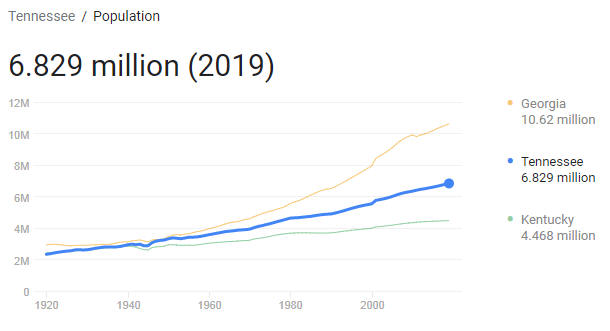Tennessee, abbreviated TN and Tenn., is a state in the United States, east of the Mississippi River, with the Appalachian mountain range dominating in the east.
The state has an area of 109 152 km2 and has 6 715 984 residents (US Census, 2017). The capital and largest city is Nashville. Tennessee is also called The Volunteer State.
Geography
The plain east of the Mississippi gradually rises up toward the Cumberland Plateau, which falls steeply east toward the Great Appalachian Valley. In the Appalachian furthest east, the Great Smoky Mountains reach 2025 meters above sea level. in Clingman’s Dome. The Tennessee River follows the Tennessee Valley with a number of large dam facilities; important bees are Duck and Cumberland which come from the Cumberland Plateau in the east. Almost half the area is wooded, deciduous forests dominate, and includes a variety of species such as oak, beech, hickory, plane and walnut. In the Appalachians, pine, spruce and precious fir grow.
Population
The most densely populated are the Tennessee Valley and the plain along the Mississippi River. Black / African Americans make up 17.1 percent of the population, and are particularly resident in the largest cities (US Census, 2017). 66.4 per cent of the population live in cities or urban areas (2010). The largest cities are the capital city of Nashville with 667 560 residents, Memphis with 652 236 residents, Knoxville with 187 347 residents and Chattanooga with 179 139 residents (US Census, 2017). Baptists and Methodists are the dominant denominations in the state.
Tennessee sends two senators and nine representatives to the federal congress in Washington DC.
Business
Important agricultural commodities are soybeans, tobacco and cotton; moreover, wheat, corn, fruits and vegetables are grown. Animal husbandry with the production of meat and dairy products is important in higher-lying parts of the state.
Coal is recovered on the Cumberland Plateau and in the Appalachians; in addition, zinc, phosphate, sulfur coffin, copper and marble are extracted. Tennessee is the United States’ largest producer of zinc and sulfur coffin; Coal and hydropower are important sources of energy. The industry has been heavily developed through the Tennessee Valley Authority.
The chemical industry is dominant; in addition, food and beverages, textiles and clothing, metal products and electrical equipment are manufactured. The largest industrial areas are found in the mineral and hydropower-rich east, with Chattanooga, Knoxville and Morristown as important industrial cities.
Tennessee has a well-developed road network, as well as good rail and air connections with the rest of the United States. The state is widely visited by tourists, the Appalachians by many hikers. The city of Nashville is especially known for its folk (country).
History
Spanish explorers were the first Europeans to arrive in today’s Tennessee in the 16th century, but the area was first colonized in 1769 by immigrants from Virginia. In 1796, Tennessee became its own state, as the 16th in a row. Tennessee joined the Southern States during the American Civil War 1861-1865, and a number of major battles were fought here.











